White beans, chorizo, and kale. With classic Spanish chorizo this dish is wonderfully flavorful and warming. The peculiar sweetness of kale balances the spicy, smoky chorizo.
Not hard:
2 Tbs olive oil
1 onion, chopped
1 bell pepper, chopped
3 cloves garlic, minimum
chorizo, several inches worth, chopped to whatever size. Medallions are popular/picturesque but I like smaller pieces. Chorizo imported from Spain or in the Spanish style is ideal. Portuguese linguica is an OK substitute, any other substitution will require the addition of herbs and pimentón to supply the flavor.
splash of wine
2 cans cannelini beans, rinsed
8 oz broth, your preference
plenty of shredded kale, probably you will wish you had added more
Saute onions, peppers, garlic in olive oil (a dutch oven is nice for this dish), let them get plenty of color. Add the chorizo, allow fat to render. De-glaze with whatever wine you are drinking (I prefer white with this dish, a Sauvignon Blanc maybe, or Chardonnay, or sherry!). Mix in the beans and add the broth (I like beef broth here). Add the kale (I don’t even bother to mix it in at this point, just leave it on the top) and cover to allow the kale to steam. Once it has wilted, mix in. The longer everything can simmer at this point, the better. Say, 20 minutes. Chorizo is traditionally a dry sausage, and takes time to soften, also the flavors have time to mingle.
You can add more or less broth depending on how soupy you would like the final result, this combination is popular as an actual soup as well. All quantities are flexible.
Serve with toast.
x
[This recipe is adapted from one from about.com, which I can’t find anymore.]





